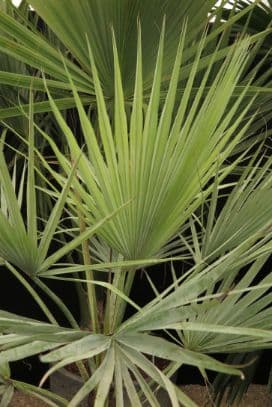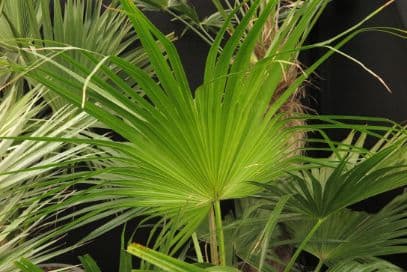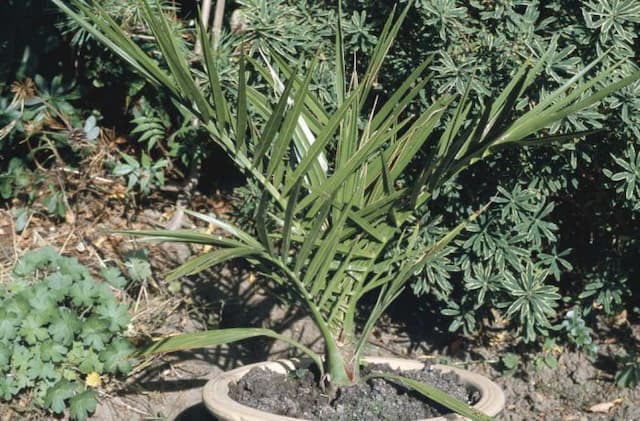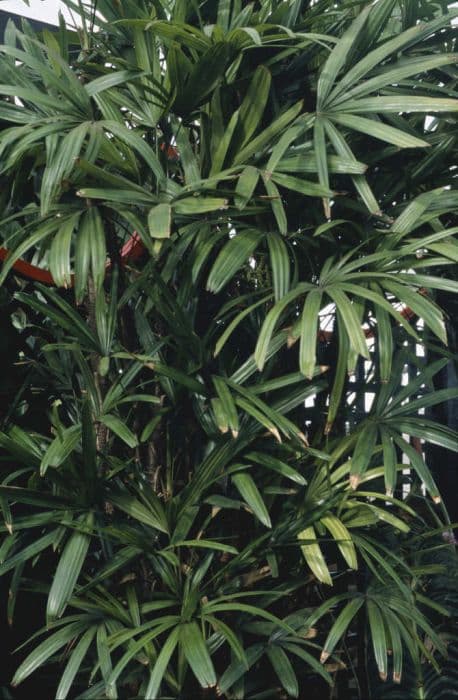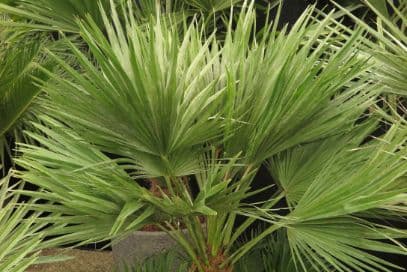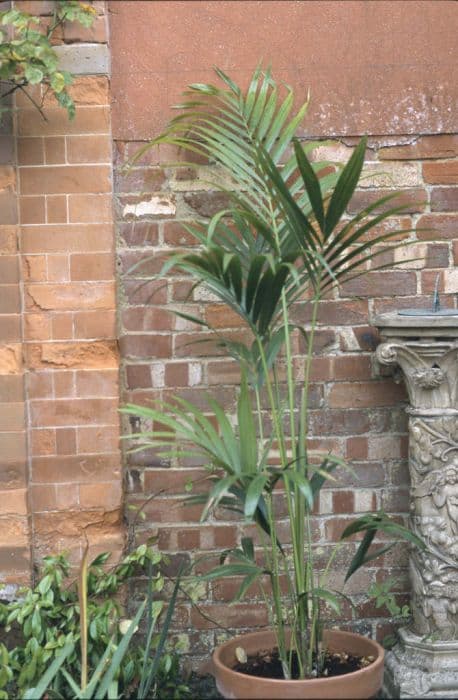Fishtail palm Caryota mitis

ABOUT
The plant commonly known as the fishtail palm gets its name from its unique leaves, which resemble the tail fin of a fish. These bipinnate leaves feature jagged edges and are made up of several leaflets on each side of the central stem, giving it a striking and feathery appearance. The leaflets are arranged in a herringbone pattern which further accentuates the fishtail-like design. This palm has a clumping growth habit, meaning it often produces multiple stems or trunks that grow close together. As it matures, the fishtail palm can develop a textured, fibrous trunk with a pattern of scars where old leaves have fallen away. The overall look of the fishtail palm is tropical and lush, contributing to its popularity as an ornamental plant in gardens and indoor settings. The plant may bear clusters of flowers that are hidden among the leaves, and these can give way to small, round fruits. The colour of its foliage is typically a rich green, providing a vibrant canopy that adds to its ornamental value.
About this plant
 Names
NamesFamily
Arecaceae.
Synonyms
Burmese Fish Tail Palm, Clustered Fishtail Palm, Feather Palm, Fishtail Palm, Tufted Fishtail Palm, Wine Palm.
Common names
Caryota furfuracea, Caryota sobolifera, Caryota nana, Caryota propinqua, Caryota griffithii, Thuessinkia speciosa, Caryota javanica, Drymoglossum zippelii, Caryota densiflora, Caryota cumingii, Caryota sobolfiera, Caryota mitis var. genuina, Caryota mitis var. tenuis.
 Toxicity
ToxicityTo humans
The Caryota mitis, commonly known as the fishtail palm, contains calcium oxalate crystals which can be toxic to humans. If ingested, parts of the plant can cause symptoms such as a burning sensation in the mouth and throat, swelling of the lips, tongue, and throat, difficulty swallowing, and possibly stomach upset. Handling the plant may also result in skin irritation for sensitive individuals. It is important to avoid ingestion and to wear gloves when pruning or handling to minimize the risk of skin irritation.
To pets
The Caryota mitis, known as the fishtail palm, possesses calcium oxalate crystals that are toxic to pets. If a pet ingests parts of this plant, they may experience oral irritation, intense burning and irritation of the mouth, tongue, and lips, excessive drooling, vomiting, and difficulty swallowing. It is crucial to prevent pets from chewing on or ingesting any part of the plant, as the symptoms can be distressing and may require veterinary attention.
 Characteristics
CharacteristicsLife cycle
Perennials
Foliage type
Evergreen
Color of leaves
Green
Height
10-25 feet (3-7.6 meters)
Spread
6-10 feet (1.8-3 meters)
Plant type
Palm
Hardiness zones
10
Native area
Southeast Asia
Benefits
 General Benefits
General Benefits- Aesthetic Appeal: Caryota mitis, commonly known as the Fishtail Palm, is known for its unique, bipinnate leaves that resemble the tail of a fish, adding a tropical and decorative look to gardens and indoor spaces.
- Shade Provider: With its broad foliage, the Fishtail Palm offers a natural canopy that can provide shade in gardens, patios, or public spaces, making it a valuable plant for hot and sunny climates.
- Habitat for Wildlife: The Fishtail Palm can serve as a habitat and food source for various species of birds and small animals, especially in its natural environment.
- Low Maintenance: Caryota mitis is relatively easy to care for once established, with moderate watering needs and no extreme pruning requirements.
- Drought Tolerance: The palm is capable of withstanding periods of dryness, making it suitable for xeriscaping and landscapes with water usage concerns.
- Soil Adaptability: It can adapt to a range of soil types, from clay to sandy soils, provided they offer good drainage.
- Wind Resistance: Thanks to its sturdy trunk and flexible fronds, the Fishtail Palm can tolerate windy conditions, making it useful in coastal areas and high-rise urban landscapes.
 Medical Properties
Medical Properties- This plant is not used for medical purposes.
 Air-purifying Qualities
Air-purifying QualitiesThis plant is not specifically known for air purifying qualities.
 Other Uses
Other Uses- Fish Poison: In some traditional societies, compounds from the Caryota mitis, commonly known as fishtail palm, are used to stun or kill fish, making them easier to catch.
- Traditional Rituals: The fishtail palm's leaves and flowers may be utilized in some cultures for ceremonies and rituals for their symbolic significance.
- Thatching Material: The leaves of the fishtail palm can be used as a natural thatching material for roofing in rural areas, providing shelter from the elements.
- Handicrafts Material: The fibers from fishtail palm can be woven into various handicrafts, including baskets, mats, and other decorative items.
- Animal Fodder: The leaves of the fishtail palm may sometimes serve as fodder for livestock in certain regions where other food sources are scarce.
- Alcoholic Beverages: The sap obtained from the fishtail palm can be fermented to produce traditional alcoholic drinks in some cultures.
- Dye Production: Parts of the fishtail palm, like the fruits, may be used to produce natural dyes for coloring textiles or crafts.
- Ornamental Use: With its unique leaf structure, Caryota mitis is often used for ornamental purposes in landscapes and indoor decoration.
- Privacy Screens: The dense growth habit of the fishtail palm makes it an excellent natural privacy screen for residential gardens or patios.
- Culinary Use: While not common, some parts of the fishtail palm, such as the palm heart, may be consumed as a vegetable in certain traditional dishes.
Interesting Facts
 Feng Shui
Feng ShuiThe Fishtail Palm is not used in Feng Shui practice.
 Zodiac Sign Compitability
Zodiac Sign CompitabilityThe Fishtail Palm is not used in astrology practice.
 Plant Symbolism
Plant Symbolism- Resilience: Caryota mitis, commonly known as the Fishtail Palm, possesses the ability to thrive in various environmental conditions, symbolizing adaptability and persistence in the face of challenges.
- Endurance: The Fishtail Palm's sturdy trunk and evergreen nature represent endurance and the capacity to withstand time and adversity.
- Tropical Beauty: With its unique fishtail-shaped leaves, the Fishtail Palm is often associated with tropical beauty and lushness, evoking feelings of relaxation and paradise.
- Growth: As the Fishtail Palm can grow fairly quickly under the right circumstances, it symbolizes personal or spiritual growth and the idea of constantly pushing towards betterment.
 Water
WaterThe fishtail palm should be watered when the top inch of soil begins to feel dry to the touch. Generally, this means watering the plant every one to two weeks, depending on the humidity and temperature conditions of the environment. Use room temperature water and pour slowly around the base of the plant until the water begins to drain through the bottom of the pot, which may be around 16-32 ounces for smaller pots and up to 1-2 gallons for larger specimens. Always allow the excess water to drain away, as fishtail palms are sensitive to waterlogged soil.
 Light
LightThe fishtail palm requires bright, indirect light to thrive. Direct sunlight can scorch the leaves, while too little light may cause slow growth and fewer leaves. The ideal spot for a fishtail palm would be near a window with diffused natural light; a north or east-facing window is often an optimal location.
 Temperature
TemperatureFishtail palms do best in temperatures between 60 and 85 degrees Fahrenheit. They can tolerate a minimum temperature of around 55 degrees Fahrenheit and should not be exposed to cold drafts or temperatures below this, as they are not cold hardy. The optimal temperature range allows for healthy growth and development.
 Pruning
PruningPruning of the fishtail palm is typically done to remove dead or damaged fronds or to control its size within a given space. It's best to prune the palm in the spring or summer when it is actively growing. Only prune fronds that are brown or obviously damaged, cutting them back to the base with clean and sharp pruning tools to prevent disease transmission.
 Cleaning
CleaningAs needed
 Soil
SoilFishtail Palm thrives in well-draining, fertile potting soil with a pH of 6.0 to 7.0. A mix containing peat, pine bark, and perlite or sand works well to maintain the necessary balance of moisture retention and drainage.
 Repotting
RepottingThe Fishtail Palm should be repotted every 2 to 3 years, or when it has outgrown its current pot, with fresh soil to prevent root-bound conditions and to replenish nutrients.
 Humidity & Misting
Humidity & MistingFishtail Palms prefer high humidity conditions, ideally around 50-60%, which can be maintained by regular misting or using a humidifier in dry environments.
 Suitable locations
Suitable locationsIndoor
Place Fishtail Palm in bright, indirect light and ensure high humidity.
Outdoor
Grow Fishtail Palm in partial shade and protect from cold drafts.
Hardiness zone
10-12 USDA
 Life cycle
Life cycleThe Fish Tail Palm (Caryota mitis) begins its life as a seed that germinates in moist, warm soil, developing into a seedling with a single shoot and root system. As it matures into a young plant, it develops characteristic bipinnate, fishtail-like leaves. During its growth phase, the palm forms a clumping trunk with multiple stems and continues to expand its leaf canopy. The Fish Tail Palm reaches reproductive maturity and produces flowering inflorescences, which hang in clusters and contain both male and female flowers. After pollination, the flowers develop into small, round fruits that contain seeds. Once a stem has flowered, it will eventually die, but the clump continues to grow and produce new stems and flowers, perpetuating the species.
 Propogation
PropogationPropogation time
Spring to summer
Propogation: The most popular method for propagating the Caryota mitis, commonly known as the Fishtail Palm, is through seed germination. This process begins with the collection of ripe fruits from the palm, which typically occurs when they turn a dark purple or black color. The seeds are then extracted from the fruit and cleaned to remove any remaining pulp, which can inhibit germination. Prior to sowing, it's often recommended to soak the seeds in water for at least 24 hours to hydrate them and stimulate the germination process. The soaked seeds can then be sowed in a well-draining seed-starting mix, placing them at a depth of about half an inch (1.27 cm). The containers should be kept warm, roughly around 85 degrees Fahrenheit (29.4 degrees Celsius), and consistently moist until seedlings emerge, which may take several weeks to a few months depending on conditions. After germination, seedlings can be carefully transplanted to individual pots and allowed to grow on until they are large enough to be transplanted to their permanent location.
